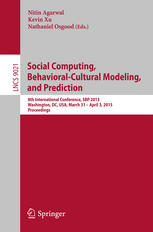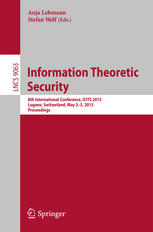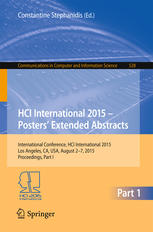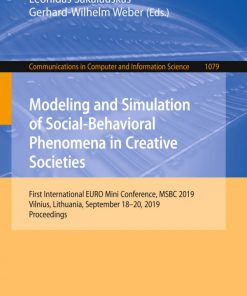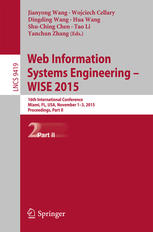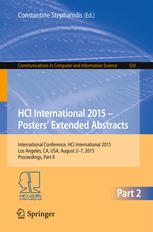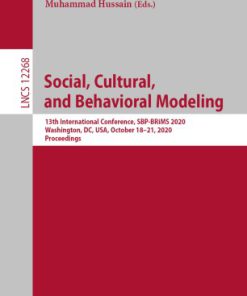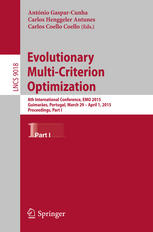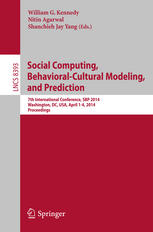Social Computing Behavioral Cultural Modeling and Prediction 8th International Conference SBP 2015 Washington DC USA March 31 April 3 2015 Proceedings 1st Edition by Nitin Agarwal, Kevin Xu, Nathaniel Osgood ISBN 3319162683 9783319162683
$50.00 Original price was: $50.00.$25.00Current price is: $25.00.
Social Computing Behavioral Cultural Modeling and Prediction 8th International Conference SBP 2015 Washington DC USA March 31 April 3 2015 Proceedings 1st Edition by Nitin Agarwal, Kevin Xu, Nathaniel Osgood – Ebook PDF Instant Download/Delivery: 3319162683, 9783319162683
Full download Social Computing Behavioral Cultural Modeling and Prediction 8th International Conference SBP 2015 Washington DC USA March 31 April 3 2015 Proceedings 1st Edition after payment
Product details:
ISBN 10: 3319162683
ISBN 13: 9783319162683
Author: Nitin Agarwal, Kevin Xu, Nathaniel Osgood
This book constitutes the refereed proceedings of the 8th International Conference on Social Computing, Behavioral-Cultural Modeling, and Prediction, SBP 2015, held in Washington, DC, USA, in March/April 2015. The 24 full papers presented together with 36 poster papers were carefully reviewed and selected from 118 submissions. The goal of the conference was to advance our understanding of human behavior through the development and application of mathematical, computational, statistical, simulation, predictive and other models that provide fundamental insights into factors contributing to human socio-cultural dynamics. The topical areas addressed by the papers are social and behavioral sciences, health sciences, engineering, computer and information science.
Social Computing Behavioral Cultural Modeling and Prediction 8th International Conference SBP 2015 Washington DC USA March 31 April 3 2015 Proceedings 1st Table of contents:
1 Introduction
2 Problem Formulation
3 Related Work
4 Data Source
5 Visualization Tool: Trending Hashtags Forecaster
6 Methodology
6.1 Network Based Model
7 Experiment Results and Findings
7.1 Features Correlated with Breaking Hashtags
7.2 Network Based Model
8 Conclusion and Future Work
References
Temporal Causality of Social Support in an Online Community for Cancer Survivors
1 Introduction
2 Temporal Causality
3 Methodology
3.1 Learning Sentiment Classifier for Posts
3.2 Cancer Survivor Network Thread as a Sequence of Sentiments
3.3 Probabilistic Kripke Structure in CSN
4 Temporal Causality in Cancer Survivor Network
4.1 Prima Facie Cause
4.2 Assessing the significance of causes
5 Summary and Future Work
References
Are You Satisfied with Life?: Predicting Satisfaction with Life from Facebook
1 Introduction
2 Related Work
3 Data Description
3.1 Features and the Target Variable
3.2 Sample Size
4 Methods
4.1 Model Selection
5 Experiment
5.1 Experimental Setting
5.2 Experimental Results
6 Conclusion and Future Work
References
Social Computing for Impact Assessment of Social Change Projects
1 Introduction
2 Background
3 Method
4 Results
5 Discussion and Conclusion
References
Social Network Extraction and High Value Individual (HVI) Identification within Fused Intelligence D
1 Introduction
2 Social Network Extraction and HVI Modules
2.1 Ground Truth Social Network Extraction
2.2 Cumulative Data Graph Social Network Extraction
2.3 Comparison Between CDGSN and GTSN
3 Hop Threshold Optimization
4 Training and Test Data Set Results
5 Conclusion
References
Structural Properties of Ego Networks
1 Introduction
2 Background and Related Work
3 Structural Features of Ego Networks
3.1 Degree Distribution
3.2 Degree Assortativity and Clustering Coefficient
4 Conclusion
References
Conflict and Communication in Massively-Multiplayer Online Games
1 Introduction
2 Related Work
2.1 Game X
2.2 Travian
3 Analysis
4 Discussion
5 Conclusion and Future Work
References
The Impact of Human Behavioral Changes in 2014 West Africa Ebola Outbreak
1 Introduction
2 Methods and Materials
2.1 Model
2.2 Model Calibration
2.3 Sensitivity Analysis
3 Results
4 Conclusion
Reference
Social Complexity in the Virtual World
1 Introduction
2 Methodology
3 Results
3.1 Hill Estimation
4 Discussion
5 Conclusion
References
A Model of Policy Formation Through Simulated Annealing: The Impact of Preference Alignment on Produ
1 Introduction
2 Model and Methods
2.1 Model Overview
2.2 Model Initialization
2.3 Simulation Algorithm Overview
2.4 Model Calibration
2.5 Experiments
3 Results and Findings
4 Discussion
4.1 Implications for Future Research
5 Summary
References
VIP: Incorporating Human Cognitive Biases in a Probabilistic Model of Retweeting
1 Introduction
2 The VIP Model
2.1 Learning Parameters
2.2 Prediction
3 Evaluation
3.1 Model Selection
3.2 User–Item Adoption Prediction
4 Visibility vs Item Fitness vs Personal Relevance
5 Conclusion
References
The Influence of Collaboration on Research Quality: Social Network Analysis of Scientific Collaborat
1 Introduction
2 Theory
3 Method
4 Data
5 Analysis and Findings
6 Conclusion
References
Detecting Rumors Through Modeling Information Propagation Networks in a Social Media Environment
1 Introduction
2 Related Work
3 Our Method
3.1 Problem Formulation
3.2 Information Propagation Model under Credible Message Mode
3.3 Information Propagation Model under Rumor Mode
3.4 Microblog Classification
4 Experiments
4.1 Data Collection
4.2 Experimental Results
5 Conclusion
References
Subjective versus Objective Questions: Perception of Question Subjectivity in Social Q&A
1 Introduction
2 Related Work
3 Annotation Method
4 Question Subjectivity Detection
4.1 Feature Engineering
4.2 Classification Evaluation
5 Impact of Question Subjectivity on User Behavior
5.1 Characterizing the Subjective and Objective Questions
5.2 Characterizing the Subjective and Objective Answers
6 Discussion and Conclusion
References
Analysis of Music Tagging and Listening Patterns: Do Tags Really Function as Retrieval Aids?
1 Introduction
2 Background
3 Dataset
4 Analyses and Results
4.1 RQ1: Comparison of Tagged and untagged Time-Series
4.2 RQ2: Tag Analysis
5 Conclusion
References
A Novel Mental State Model of Social Perception of Brand Crisis from an Entertainment Perspective
1 Introduction
2 Brand Crisis in Social Media
3 Theories in the Psychology of Entertainment
4 Mental State Model
5 Multi-agent Simulation Model
6 Conclusion
References
Network-Based Group Account Classification
1 Introduction
2 Theoretical Basis
3 Methods
3.1 Data Source and Preprocessing
3.2 Directed @mention Network
3.3 Bidirected @mention Network
3.4 Network Metrics
3.5 Ground-Truth Labels
4 Evaluation
5 Discussion
References
Persistence in Voting Behavior: Stronghold Dynamics in Elections
1 Introduction
2 Definitions and Methods
2.1 Model Definition and Analytical Description
3 Results
4 Discussion
References
Efficient Learning of User Conformity on Review Score
1 Introduction
2 Model
3 Learning Algorithm
4 Experiments
4.1 Learning Results
4.2 Evaluation of Conformity Metrics
5 Conclusion
References
Are Tweets Biased by Audience? An Analysis from the View of Topic Diversity
1 Introduction
2 Topics Extraction
2.1 Semantic Relatedness Measure
2.2 Clustering
3 Dataset and Results
3.1 Dataset
3.2 Resulting Clusters (Topics)
3.3 Relating Content Diversity with Audience Size
4 Discussion
References
Advantages of Cooperative Behavior During Tsunami Evacuation
1 Introduction
2 Related Work
3 Model Description
3.1 World Representation
3.2 Agents Knowledge
3.3 Agents Speed
3.4 Behavior Types
3.5 Decision Process
4 Experimental Setup
5 Results
6 Conclusion
References
Learning Automated Agents from HistoricalGame Data via Tensor Decomposition
1 Introduction and Motivation
2 Three Problem Statements
3 Why Game Theory is Not Applicable
4 A Tensor Decomposition Formulation
5 Using Tensor Decompositions to Address Our Core Problems
6 Experimental Results
7 Conclusion and Future Work
References
A Comparative Study of Symptom Clustering On Clinical and Social Media Data
1 Introduction
2 Methods
2.1 Data Sources
2.2 Data Analysis
3 Results
3.1 Symptom Clustering Results of Social Media Data
3.2 Symptom Clustering Results of Clinical Data
4 Discussion
5 Conclusion
References
Women’s Right to Drive: Spillover of Brokers, Mobilization, and Cyberactivism
1 Introduction
2 Women’s Right to Drive Movements
3 Literature Review
3.1 Social Movement Spillover
3.2 Computational Analysis of Events
4 Methodology
4.1 Data Collection for the Campaigns
4.2 Tweet Classification and Overlap Detection
5 Analysis and Results
5.1 Diffusion of Activists and Supporters
5.2 Diffusion of Hashtags and Other Resources
6 Conclusion
References
Poster Presentations
A Mathematical Epidemiology Approach for Identifying Critical Issues in Social Media
1 Introduction
2 Related Work
3 Datasets
4 The Mathematical Model
5 Model Evaluation
6 Conclusion
References
Analyzing Deviant Cyber Flash Mobs of ISIL on Twitter
1 Introduction
2 Literature Review
3 Conceptual Framework of DCFM
4 Methodology
5 Looking Ahead
References
Social Behavior Bias and Knowledge Management Optimization
1 Introduction
2 Related Work
3 Data Collection and Results
4 Conclusions
References
Passive Crowd Sourcing for Technology Prediction
1 Introduction
2 Related Work
2.1 Deriving Intelligence from the `Crowd’
2.2 Technology Forecasting Methods
2.3 Event Detection
3 Technology Emergence Prediction via Open Media
3.1 Technology Prediction Corpus
3.2 Future-Leaning Temporal Expressions
3.3 Technology Phrase Detection
4 Technology Topic Phrase Tagging Results
5 Discussion
6 Conclusions and Future Work
References
How to Predict Social Trends by Mining User Sentiments
1 Introduction
2 Dataset
3 Data Representation
4 Experiments
4.1 User Daily Sentiment
4.2 User Ranking
Feature Selection Based User Filtering:
Credibility
Activity-Based Filtering
4.3 Long-Term Predictability
4.4 Dependency on Historical Data
5 Conclusions and Future Work
References
‘Linguistics-Lite’ Topic Extraction from Multilingual Social Media Data
1 Introduction
2 System Criteria
3 Application of Singular Value Decomposition to Text
4 Validation
5 Applications of the Approach and Conclusions
References
Mining Business Competitiveness from User Visitation Data
1 Introduction
2 Proposed Store Ranking Models
2.1 Modeling Store Competitive Probability
2.2 PageRank Model
2.3 CompetitiveRank Model
3 Experiments on Real Datasets
3.1 Dataset
3.2 Evaluation
4 Conclusion
References
Automatic Tonal Music CompositionUsing Functional Harmony
1 Introduction
2 Method and Related Works
3 Functional Harmony
4 Hidden Markov Model (HMM)
5 Method and Obtained Results
6 Conclusions
References
Gaming the Social System: A Game Theoretic Examination of Social Influence in Risk Behaviour
1 Introduction
2 Model Description
3 Experimental Runs
3.1 Selfer Population
3.2 Grouper Population
3.3 Hybrid Population
3.4 Intervention Condition
4 Conclusion and Future Work
References
MECH: A Model for Predictive Analysis of Human Choices in Asymmetric Conflicts
1 Introduction
2 MECH: A Model for Asymmetric Conflict
3 MECH in the Real World: Afghanistan
4 Conclusion
References
Using Topic Models to Measure Social Psychological Characteristics in Online Social Media
1 Introduction
2 Methodology
2.1 Probabilistic Topic Models
2.2 Posterior Predictive Checks
2.3 Topic Model Regularisation
3 Identity Salience and the “pro-ana” Twitter Community
3.1 Identity Salience
3.2 Data Set
4 Measurements
5 Conclusion and Further Work
References
Expanding Consumer Health Vocabularies by Learning Consumer Health Expressions from Online Health S
1 Introduction
2 Automatic Extraction of CHV from Social Media
2.1 Co-occurrence Analysis
2.2 Candidate Terms
2.3 Ranking Score
3 Experiment
3.1 Extracting Consumer ADR Expressions
3.2 Extracting ADR Related Threads Using Expanded CHV
4 Conclusion
References
Identifying Correlates of Homicide Rates in Michoacán, Mexico
1 Background
2 Problem and Objectives
3 Data and Methodology
4 Results and Discussion
5 Conclusions and Future Work
References
A Preliminary Model of Media Influence on Attitude Diffusion
1 Introduction
2 MAMA Model Description
2.1 Attitude Change
2.2 Model Dynamics
2.3 Agenda Setting
3 Experiments
4 Related Work and Conclusions
References
A Study of Daily Sample Composition on Amazon Mechanical Turk
1 Introduction
1.1 Data Collection
2 Results
3 Discussion
4 Conclusion
References
The Controlled, Large Online Social Experimentation Platform (CLOSE)
1 Introduction
2 Overview of the CLOSE System
2.1 Architecture
2.2 Subject Pool
3 Related Work
4 Conclusion
5 Conclusion
References
Early Prediction of Movie Success — What, Who, and When
1 Introduction
2 Feature Engineering
2.1 Who are Involved
2.2 When a Movie will be Released
3 Experiments and Results
3.1 Experiment Setup and Results
3.2 Discussions
4 Conclusions and Limitations
References
Risk Management in Asymmetric Conflict: Using Predictive Route Reconnaissance to Assess and Mitigate
1 Introduction
2 MECH Behavior Model and Tactical Risks
3 Case Studies
4 Conclusions
References
Styles in the Fashion Social Network: An Analysis on Lookbook.nu
1 Introduction
2 Related Works on Fashion Analysis
3 Data Collection: Lookbook.nu
4 Experiment
4.1 Network Transformation, Community Detection and Styles
4.2 Correlation Between Following/Follower and Styles
5 Result
6 Conclusions and Future Work
References
Beyond Mere Following: Mention Network, a Better Alternative for Researching User Interaction and Be
1 Introduction
2 Related Works
3 Methodology
4 Empirical Study
4.1 Collecting Data and Mention Networks
4.2 Results
5 Conclusion
References
Agent-Based Models of Copycat Suicide
1 Introduction
2 The Model
3 Simulation Scenarios
4 Results
5 Discussion and Conclusion
References
Analyzing Second Screen Based Social Soundtrack of TV Viewers from Diverse Cultural Settings
1 Introduction
2 Related Work
2.1 Social TV (sTV) and Second Screen Usage
2.2 Conversation in Social Soundtrack
3 Research Question
4 Data Collection and Analysis
5 Results
6 Discussion
7 Conclusion
References
Error-Correction and Aggregation in Crowd-Sourcing of Geopolitical Incident Information
1 Introduction
2 Related Work
3 Methodology
3.1 Crowd-Sourcing
3.2 The Question Tree
3.3 Prediction Targets
3.4 Approaches to Predicting Targets
4 Results
5 Conclusion
References
Socio-Spatial Pareto Frontiers of Twitter Networks
1 Introduction
2 Methods
2.1 Pareto Optimality
2.2 Pareto Front Algorithm
3 Twitter Dataset
4 Results
5 Related Work and Conclusion
References
SOR: A Protocol for Requests Dissemination in Online Social Networks
1 Introduction
2 General Social Priority Framework
3 SOR Overview
3.1 SOR Messages
3.2 SOR Architecture
3.3 Protocol
3.4 SOR Routing Algorithms
4 Experimental Results
5 Conclusion
References
Resilience of Criminal Networks
1 Introduction
2 Operation Cash Network
3 Ex-Inmates Network
4 Conclusion
References
Modeling Group Dynamics for Personalized Group-Event Recommendation
1 Introduction
2 Related Work
3 Our Approach
3.1 Problem Statement
3.2 Personalized Group-Event Recommender (PGER)
4 Experiments
4.1 Dataset Description
4.2 Experimental Settings
4.3 Evaluated Recommendation Approaches
4.4 Results
4.5 Learned Group Preferences vs. Aggregating User Preferences
4.6 Examining Latent Spaces of Groups and Events
5 Summary and Future Work
References
Determinants of User Ratings in Online Business Rating Services
1 Introduction
2 Background and Related Work
3 Materials and Methods
3.1 Data Sets
3.2 Factors Influencing User Ratings
3.3 Modeling User Ratings
4 Results
4.1 Effectiveness of Identified Feature Classes
4.2 Feature Class Significance
4.3 Robustness
5 Discussion and Conclusion
References
Social Support and Stress in Autism Blogging Community on Twitter
1 Introduction
2 Related Work
3 Methods and Data
4 Results
5 Conclusion and Future Works
References
Dynamics of a Repulsive Voter Model
1 Introduction
2 Repulsive Voter Model Dynamics
3 Discussion and Numerical Results
3.1 The Equilibrium Density
3.2 Progression of the Density Function
4 Conclusions
References
Ride Sharing: A Network Perspective
1 Introduction
2 Datasets
3 Results
4 Summary and Future Work
References
Complex Interactions in Social and Event Network Analysis
1 Introduction
2 Minimizing Secondary Cuts in Graph Segmentation
3 Node Density Cuts: Graph Segmentation Based on Similarity of Post-Cut Node Set Weight and Quantity
4 Future Directions
References
Quantifying Tactical Risk: A Framework for Statistical Classification Using MECH
1 Introduction
2 Related Work
3 Road Risk Assessment Based on SML
4 Experiment, Result and Analysis
5 Conclusion
References
An Analysis of MOOC Discussion Forum Interactions from the Most Active Users
1 Introduction
2 Related Work
3 MOOC Forum
4 Research Question
5 Method
6 Result and Discussion
6.1 Are Active Users More Influential?
6.2 Do Active Users Make Positive Course Contributions?
7 Conclusion
References
Inferring User Interests on Tumblr
1 Introduction
2 Problem Formulation
3 Experiment
4 Conclusion
References
Residential Mobility and Lung Cancer Risk: Data-Driven Exploration Using Internet Sources
1 Introduction
2 Methods
2.1 Data Sources
2.2 Number of Relocations in Lifetime
3 Results
3.1 Online Obituary Dataset
3.2 Augmented LinkedIn Dataset
4 Discussion
People also search for Social Computing Behavioral Cultural Modeling and Prediction 8th International Conference SBP 2015 Washington DC USA March 31 April 3 2015 Proceedings 1st:
social computing behavioral cultural modeling and prediction
social cognitive theory of behavioural change
social behavior examples
social-behavioral modeling for complex systems
social cultural behavior
Tags:
Nitin Agarwal,Kevin Xu,Nathaniel Osgood,Social Computing,Cultural Modeling,Prediction,International Conference
You may also like…
Computers - Computer Science
Computers - Computer Science
Computers - Computer Science
Computers - Computer Science
Computers - Networking


